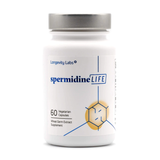
*The following article is a summary of the findings from a recent study titled "Polyamines in Food." Further information and details on this study are located in the links below.*
Polyamines are an important part of cellular life and death, protein synthesis, and gene expression and translation. They’re naturally occurring and are present in every living organism. While our body endogenously produces most polyamines, as we age they begin to deteriorate which means we must find other sources of these important biological managers. Polyamines can be found in a wide range of foods, with varying concentrations. The polyamines spermidine, spermine and putrescine are important for several different biological functions, specifically cell proliferation and cell recycling. They also have anti-inflammatory properties, which play a huge role in the prevention of chronic diseases. Polyamines are broken down and absorbed in the gut and large intestine. They are then partially metabolized in the intestinal wall and distributed throughout the body through our bloodstream. When these polyamines reach their destination in different tissues throughout the body, they are further broken down to provide necessary building blocks for change and growth.
While polyamines are important for smooth everyday function, they are especially important during periods of rapid cell growth - development in the womb, after surgery, during wound healing and as the aging process occurs. They help develop the GI tract, encourage the development of the immune system, and the maturation of the liver and the pancreas.
As mentioned above, in aging, our body’s natural levels of spermidine and spermine decrease causing our cellular renewal process to slow down. This slowing down of our cellular renewal process creates a backup of damaged or dead cells which can lead to disease commonly associated with aging. Spermidine increases our body’s levels of autophagy, which helps to clear out damaged or dead organelles and slows the aging process at a cellular level. A diet rich in spermidine helps reduce the risk of all-cause mortality. Pathologies associated with inflammatory responses in the organs, such as cardiovascular disease, see a marked improvement when spermidine intake is increased. This is due to the anti-inflammatory properties these polyamines provide.
Spermidine is especially abundant in foods of plant origin and is generally considered the predominant polyamine. The foods with the highest spermidine levels are: fruits, vegetables, legumes and soy derivatives, particularly wheat germ. Some of the more common of these foods being: Mushrooms, hazelnuts, peas, pistachios, green beans, cauliflower and broccoli.
There are a number of factors which influence the spermidine content in plant-derived foods and products. The origin of the food/product, growing conditions, harvesting methods and storage all affect the variability of spermidine concentration and content.
The preparation and cooking of foods can also potentially decrease the spermidine content in foods through two possible mechanisms: one, use of water and two, high temperatures reached in some types of cooking. One study found cooking techniques involving high temperatures, roasting, grilling and frying, produced losses of up to 60% spermidine and spermine content. While the extent and number of studies conducted on the effect culinary treatment has on spermidine and spermine content are limited, it can be inferred that highly processed foods contain significantly lower amounts of spermidine.
Polyamines play an important role in our overall health. They are responsible for protein synthesis, gene expression, cell proliferation, autophagy regulation, in addition to having anti-inflammatory and antioxidant properties. These combined can lead to a reduction in chronic diseases and pathologies often associated with aging, such as cardiovascular disease and diabetes. Currently there is no recommended level of daily polyamine intake, and levels can vary based on regional diets.
References:
- Muñoz-Esparza NC, Latorre-Moratalla ML, Comas-Basté O, Toro-Funes N, Veciana-Nogués MT and Vidal-Carou MC (2019) Polyamines in Food. Front. Nutr. 6:108. doi: 10.3389/fnut.2019.00108







